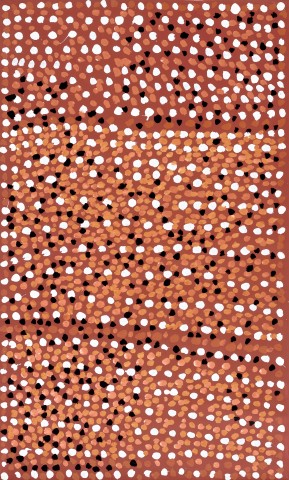BODY MARKS, 1998
PRINCE OF WALES (MIDPUL)
synthetic polymer paint on linen
152.0 x 91.5 cm
bears inscription verso: artist's name, title, date and cat. 00206
Karen Brown Gallery, Darwin
Galerie Exler, Frankfurt, Germany
Private collection, Hesse, Germany
Van Ham Kunstauktionen, Cologne, Germany, 17 June 2020, lot 787
Private collection, United Kingdom
Renowned for his unique interpretations of body decorations and markings used in the ceremonial activities of the Larrakia people, Prince of Wales (Midpul) drew inspiration from these traditional activities for the imagery in his contemporary paintings. Born Midpul at Kah'lin (Cullen) Beach, Darwin in 1935, Prince grew up at Belyuen (Dellisaville), a small community on the far side of Darwin Harbour. He was the son of acknowledged Larrakia leader and traditional land owner Imabul (Old King George) and was also known as Prince of Wales – a title that was re-enforced when he danced for Queen Elizabeth during a royal trip to Australia in the 1960s. A custodian and leader of Larrakia ceremonies and dances, a leading didgeridoo player and ceremonial body painter for much of his life, Prince started painting in 1995, initially on discarded pieces of wood and cardboard, and participated in his first exhibition the following year
'In taking up painting, Prince found a medium through which he could retain the essence of his active ceremonial life. His paintings have a musicality imparted by the lively staccato effect of the dots and intermittent bars, as if to read like sheet music for an improvised symphony. Prince's uninhibited use of colour belies the origins of these designs which were passed on by his ancestors as marks on the bodies of ceremonial participants.'1
Painted on an ochre ground, Body Marks, 1998 reinforces the ceremonial body decorations that Prince of Wales wanted to preserve in his painting. The alternate-coloured dotting of black, white, yellow and brown dots combines together to create an intense energy. These markings evoke the patterns Prince would have originally painted onto the bodies of his clansmen prior to a ceremonial dance, but here they are transferred as a permanent record for posterity.
His first solo show was in Melbourne in 1997 at Gallery Gabrielle Pizzi, and in 2001, he won the painting section at the Telstra National Aboriginal and Torres Strait Islander Art Award in Darwin.
1. Perkins, H., Tradition Today; Indigenous Art in Australia, Art Gallery of New South Wales, Sydney, 2004, p. 166
CRISPIN GUTTERIDGE
